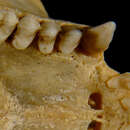en
names in breadcrumbs


The main enemies of the red-footed tamarin are small cats, birds of prey, and snakes.
Perception Channels: tactile ; chemical
The destruction of tropical rainforest threatens the habitat of the red-footed tamarin, ultimately threatening the livelihood of the species.
CITES: appendix ii
IUCN Red List of Threatened Species: least concern
Like most tamarins, the red-footed tamarin eats mainly insects, ripe fruit, and plant exudates such as sap, gum, and resin. It also includes nectar, tender vegetation, spiders, small vertebrates, and birds' eggs in its diet. Prey is killed with a bite to the head.
Animal Foods: eggs; insects; terrestrial non-insect arthropods
Plant Foods: leaves; fruit; nectar; sap or other plant fluids
Primary Diet: omnivore
The red-handed tamarin lives in northern Brazil, Guyana, French Guiana, and Surinam.
Biogeographic Regions: neotropical (Native )
The red-footed tamarins live in trees with small crowns (less than 15 m in diameter).
Terrestrial Biomes: rainforest
Average lifespan
Status: captivity: 21 years.
The head and body measure from 20.5 to 28 cm, the tail from 31.5 to 44 cm. There is no obvious sexual dimorphism. The face is black with long hairs. It does not have the whitish fur around the mouth that is characteristic of other tamarins in the long-tusked tamarin group. The body is also black, except for the hands and feet, which are orange-red or yellow. There are claws on all digits except for the big toe, which has the flattened nail characteristic of primates. Also, the thumb lacks a saddle joint and is not opposable. There are specialized scent glands in the midchest and around the genitalia, the secretions of which are used to mark territory and convey information about identity, status, and sexual receptivity of individuals.
Range mass: 400 to 550 g.
Other Physical Features: endothermic ; bilateral symmetry
The young are cared for by all adult members of a group, with males and other females assisting at birth and caring for the young when they are not being suckled. There is usually only one breeding female and two or more breeding males in a group. The suppression of reproductive activity in non-dominant females is a result of inhibitory behavior of the dominant female combined with loss of ovulatory capacity in the subordinate female.
Mating System: polyandrous ; cooperative breeder
Adult tamarins reach sexual maturity at age 16-20 months. One, usually two, or rarely three young are born after a gestation lasting 140-145 days. The young weigh about 45 grams at birth. Weaning occurs at age 2-3 months. Red-footed tamarins live to the age of 10 or more years.
Range number of offspring: 1 to 3.
Range gestation period: 140 to 145 days.
Range weaning age: 2 to 3 months.
Range age at sexual or reproductive maturity (female): 16 to 20 months.
Range age at sexual or reproductive maturity (male): 16 to 20 months.
Key Reproductive Features: iteroparous ; gonochoric/gonochoristic/dioecious (sexes separate); sexual ; viviparous
Average birth mass: 40 g.
Average number of offspring: 2.
The young are cared for by all adult members of a group, with males and other females assisting at birth and caring for the young when they are not being suckled. Females nurse their young for two to three months.
Parental Investment: pre-fertilization (Provisioning, Protecting: Female); pre-hatching/birth (Provisioning: Female, Protecting: Female); pre-weaning/fledging (Provisioning: Female, Protecting: Male, Female)